
The Symbolism of Toads
Share
Warty and still, yet charged with the wisdom of the swamp, the toad lives between worlds—neither fully of water nor land, yet belonging to both. It does not beg for beauty, nor chase attention, but waits in silence until the time is right. The toad is an emblem of hidden transformation, earth-bound alchemy, and the soul’s quiet movement through cycles of initiation and renewal.
To contemplate the toad is to encounter the archetype of the overlooked teacher, of slow magic, and of the one who carries great change in humble form.
The Ancient Dweller in Cultural Memory
In many cultures, the toad is linked to the lunar and the feminine, to moisture, fertility, and the deep power of the Earth’s belly. In Chinese symbolism, the toad is associated with wealth, immortality, and lunar cycles, often appearing as a three-legged creature upon coins or in tales of transformation. It is said to sit at the gateway of hidden realms, offering entry not through conquest, but through patience.
In Indigenous American and African traditions, the toad is seen as a bringer of rain, a spirit of renewal and rooted growth, emerging from mud and shadow to sing in resonance with the coming storm. It is a symbol of what lives in darkness but heralds life.
In alchemical imagery, the toad was considered a creature of lead, a base form waiting for transmutation, reminding the adept that the lowly may be the vessel for gold, if seen with the eyes of soul.
Stillness, Skin, and the Transformation Within
The toad is not beautiful in the ordinary sense. It does not rise, but sinks. It hides. And in this, it teaches the power of being unseen while undergoing change. Its life is a rhythm of moisture and stillness, of night calls and sudden appearances, of long silences followed by emergence.
Its skin, often coarse and bumpy, is permeable—in communion with its environment. It absorbs the world not through mouth or eye alone, but through body. This reflects a radical intimacy with nature, a willingness to be touched by life at every level.
Its call, resonant and low, carries far into the night. It sings not for dominance, but for alignment—a declaration that life stirs again, that the season of growth approaches.
Resonance with the Energy Centers
The toad resonates primarily with the red-ray energy center—the root chakra, which governs survival, groundedness, and the primal memory of the Earth’s cycles.
Its closeness to soil, its emergence from mud, and its instinctual response to rain and moisture all express a deep connection to red-ray intelligence—the wisdom of cycles, the patience of embodiment, and the power of remaining until the time is right. The toad is not in a hurry; its very stillness is a form of power.
There is also a secondary resonance with the indigo-ray energy center—the third eye chakra, which governs spiritual insight, unseen perception, and archetypal transformation.
Though humble in appearance, the toad is a vessel for metamorphosis. It represents the path of the initiate, whose transformation may not be elegant, but is thorough. It lives in shadow and emerges in song. Its indigo-ray is not visual spectacle, but deep recognition of the sacred pattern unfolding beneath appearances.
Together, red and indigo pulse through the toad as:
embodiment that prepares the soul,
transformation hidden in plain sight,
and humility shaped by archetypal force.
The One Who Transforms While Still
To walk with the toad is to learn that spiritual change is often unglamorous, that the deepest growth may happen underground, and that the sacred may wear the form of the forgotten. The toad teaches the seeker to honor stillness, to wait without panic, and to embrace the mud as the womb of becoming.
The toad does not seek light.
It lives in resonance with water and stone.
It does not move often.
But when it does, it is called by the rhythm of the Earth.
It teaches:
Remain rooted.
Let silence prepare the way.
And trust that the unseen work will become the song of transformation.